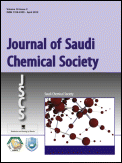
Journal of Saudi Chemical Society
Scope & Guideline
Leading the Charge in Cutting-edge Chemical Discoveries.
Introduction
Aims and Scopes
- Materials Science and Nanotechnology:
The journal publishes research on the synthesis, characterization, and application of nanomaterials, including metal nanoparticles, metal-organic frameworks (MOFs), and carbon-based nanocomposites, focusing on their potential in catalysis, drug delivery, and environmental remediation. - Green Chemistry and Sustainable Practices:
A significant emphasis is placed on eco-friendly synthesis methods, including biogenic and green approaches to nanomaterials and compounds. The journal highlights sustainable practices in chemical processes and materials. - Catalysis and Reaction Engineering:
Research on catalytic processes, including heterogeneous and homogeneous catalysis, is a core area. The journal covers the development of novel catalysts and reaction mechanisms for organic transformations and environmental applications. - Analytical Chemistry and Environmental Monitoring:
The journal includes studies on analytical methods for detecting environmental pollutants, including heavy metals and organic dyes, employing advanced techniques such as spectrometry and chromatography. - Medicinal and Pharmaceutical Chemistry:
Publications often explore the synthesis and evaluation of new pharmaceutical compounds, including their biological activities, mechanisms of action, and potential therapeutic applications. - Computational Chemistry and Molecular Modeling:
The journal features computational studies that support experimental findings, including molecular docking, density functional theory (DFT) calculations, and quantitative structure-activity relationship (QSAR) modeling.
Trending and Emerging
- Biological and Medicinal Applications of Nanomaterials:
There is an increasing trend in research focused on the synthesis of nanomaterials with specific biological applications, such as drug delivery systems and antimicrobial agents, reflecting a significant interest in health-related chemistry. - Photocatalytic and Environmental Remediation Technologies:
Recent publications show a rise in studies aimed at developing photocatalytic materials for environmental applications, particularly for wastewater treatment and degradation of pollutants, highlighting a commitment to addressing environmental issues. - Machine Learning and Artificial Intelligence in Chemistry:
Emerging themes include the integration of machine learning and AI for predictive modeling in chemical processes, particularly in drug design and materials science, showcasing a technological shift in research methodologies. - Sustainable and Green Chemistry Innovations:
The journal is increasingly publishing research that emphasizes green chemistry principles, focusing on sustainable materials and processes, as well as the use of waste materials in chemical synthesis. - Electrocatalysis and Energy Storage Solutions:
There is a notable increase in research related to electrocatalysis, particularly for energy applications such as hydrogen production and battery technologies, reflecting a growing interest in renewable energy solutions.
Declining or Waning
- Traditional Organic Synthesis:
There seems to be a waning interest in conventional organic synthesis methods without green or innovative enhancements, as the focus shifts towards more sustainable and efficient approaches. - Generalized Theoretical Studies:
Papers focusing solely on theoretical approaches without experimental validation are becoming less frequent, as there is a growing preference for studies that integrate computational modeling with practical applications. - Basic Chemical Education:
Research related to basic chemical education and pedagogical studies has decreased, indicating a shift towards more applied research that directly addresses current industrial and environmental challenges.
Similar Journals
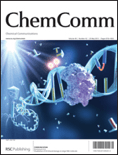
CHEMICAL COMMUNICATIONS
Showcasing the pulse of modern chemical research.Chemical Communications, published by the esteemed Royal Society of Chemistry, is a prominent journal within the field of chemical science, focusing on the dissemination of cutting-edge research in a variety of sub-disciplines including catalysis, materials chemistry, and electronic materials. Operating without an open access model, this journal provides critical insights from contributors around the globe, enhancing our understanding of complex chemical interactions and innovative applications. Ranked in the top quartile for several categories such as Ceramics and Composites, and Metals and Alloys, Chemical Communications boasts impressive Scopus rankings, securing strong positions across multiple fields and showcasing its influence within the scientific community. The journal is committed to advancing knowledge and fostering collaboration among researchers, professionals, and students, making it an invaluable resource for those looking to stay abreast of the latest advancements in chemistry and materials science. With a publication history dating back to 1965 and continuing into 2024, its rich archive serves as a vital repository of chemical research and development.
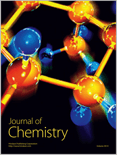
Journal of Chemistry
Fostering Collaboration in Chemical ResearchJournal of Chemistry, published by Hindawi Ltd, serves as a critical platform for advancing knowledge in the field of chemistry, particularly in its miscellaneous sub-disciplines. With an impressive 2023 Scopus Rank of #123 out of 408 and positioned in the Q2 quartile, this journal exemplifies a robust academic rigor that appeals to researchers, professionals, and students alike. It features articles related to innovative chemical research and developments, catering to a diverse audience eager to contribute to the growing body of literature in the chemical sciences. The journal has been operational from 2013 to 2024, and its Open Access model ensures that findings are easily accessible to a global audience, fostering collaboration and knowledge sharing. With a commitment to quality and relevance, the Journal of Chemistry continues to play a significant role in shaping contemporary chemical research and education.
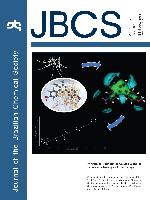
JOURNAL OF THE BRAZILIAN CHEMICAL SOCIETY
Catalyzing Knowledge: Transforming Chemistry Through Open DialogueThe Journal of the Brazilian Chemical Society (ISSN: 0103-5053; E-ISSN: 1678-4790), published by the Sociedade Brasileira de Química, stands as a prominent outlet for disseminating high-quality research in the field of chemistry. Since its establishment as an Open Access journal in 1990, it has been committed to providing unrestricted access to innovative findings and discussions that propel the advancement of chemical sciences globally. Located in the vibrant research landscape of Brazil, this journal aims to showcase a wide range of topics including analytical, organic, inorganic, and physical chemistry, among others, catering to a diverse audience of researchers, professionals, and students alike. The journal holds a noteworthy distinction with a Q3 quartile ranking in the field of miscellaneous chemistry for 2023 and is indexed in Scopus, reflecting its growing influence in the academic community. With a publication cycle that spans continuously from 1990 through 2024, it serves as a vital resource for anyone seeking to stay informed about the latest trends and breakthroughs in chemistry.
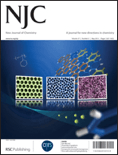
NEW JOURNAL OF CHEMISTRY
Connecting Ideas, Transforming ChemistryNEW JOURNAL OF CHEMISTRY, published by the prestigious Royal Society of Chemistry, serves as a vital platform for the dissemination of research in the dynamic fields of chemistry, catalysis, and materials science. With an impressive ISSN of 1144-0546, this journal boasts a rich history, having been established in 1996, and is set to continue its impactful publication through 2024. The journal is recognized in several categories, achieving a Q2 ranking in both chemistry and materials chemistry, and a Q3 rank in catalysis, reflecting its significance within these disciplines. Researchers will find it particularly noteworthy that the journal holds an esteemed position in the Scopus rankings, with a 65th percentile standing in general chemistry. Though it currently operates on a subscription model, its commitment to advancing the frontiers of chemistry makes it an essential resource for academics, professionals, and students seeking to keep abreast of the latest advancements and innovative methodologies in their fields.

Bulletin of the University of Karaganda-Chemistry
Catalyzing Ideas for a Sustainable Chemical FutureBulletin of the University of Karaganda-Chemistry is an esteemed academic journal published by KARAGANDA STATE UNIVERSITY, focusing on the field of chemistry and related disciplines. With an ISSN of 2518-718X and an E-ISSN of 2663-4872, this journal aims to disseminate high-quality research articles, reviews, and scholarly discussions that contribute to the advancement of knowledge in chemistry. Although it has experienced a transition in its coverage from 2021 to 2022, the journal remains a significant platform for researchers and students alike, promoting open access to its valuable content. Despite its current Scopus rank of #379/407 in the general chemistry category, the Bulletin of the University of Karaganda-Chemistry serves as a vital resource for the academic community in Kazakhstan and beyond, fostering collaboration and innovation in various chemical research domains. Researchers, professionals, and students are encouraged to engage with the journal as it continues to evolve and contribute to significant scientific discussions.

RUSSIAN CHEMICAL BULLETIN
Delivering Essential Findings for Tomorrow's Chemists.RUSSIAN CHEMICAL BULLETIN, published by SPRINGER, serves as a pivotal resource in the field of general chemistry, covering a wide array of topics that impact both theoretical and applied chemistry. With an ISSN of 1066-5285 and a presence since 1993, this journal provides a platform for disseminating significant research findings, practical applications, and novel methodologies within the broader chemistry community. While it currently holds a Q3 ranking in the Chemistry (miscellaneous) category and occupies the 230th position out of 408 in the Scopus rankings, its reputation continues to grow, fostering collaboration and innovation among researchers and professionals alike. Although the journal does not offer an open-access model, it is committed to making findings accessible within the academic community, ensuring that valuable insights can inform future research. With an anticipated convergence of studies extending to 2024, the RUSSIAN CHEMICAL BULLETIN remains an essential reference for those dedicated to advancing chemical science.

JACS Au
Elevating chemistry research with open access insights.JACS Au, published by the American Chemical Society, is a premier open access journal dedicated to advancing research in the rapidly evolving fields of analytical chemistry, organic chemistry, and theoretical chemistry. Since its inception in 2021, JACS Au has quickly established itself as a leading platform for high-quality research, reflected in its Q1 rankings across multiple categories for 2023, including Organic Chemistry and Analytical Chemistry. The journal focuses on innovative methodologies and applications that drive the discipline forward, making it an essential resource for researchers, professionals, and students alike. With an impressive Scopus ranking, consistently placing in the top tiers of its categories, and offering a broad range of access options for its readership, JACS Au aims to foster collaboration and disseminate transformative ideas that impact the global scientific community. Exploring diverse topics within chemistry, this journal provides a vital conduit for sharing groundbreaking research and enhancing scientific dialogue.
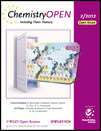
ChemistryOpen
Unlocking the Future of ChemistryChemistryOpen is a leading open access journal published by WILEY-V C H VERLAG GMBH, dedicated to advancing the field of chemistry. With its ISSN 2191-1363, this journal has been a vital platform since its inception in 2012, promoting unrestricted access to innovative research findings and critical reviews in various chemistry domains. As a testament to its growing influence, ChemistryOpen has achieved a commendable Q2 quartile ranking in the 2023 Chemistry (miscellaneous) category, which highlights its quality and impact within the academic community. Researchers, professionals, and students benefit from the journal's commitment to making high-quality research accessible, facilitating knowledge transfer and collaborative insights among chemists worldwide. The journal's transparent open access model ensures that groundbreaking discoveries and methodologies are readily disseminated, fostering a culture of innovation and interdisciplinary dialogue in the ever-evolving landscape of chemistry.

RUSSIAN CHEMICAL REVIEWS
Transforming Chemistry Through Rigorous ReviewRUSSIAN CHEMICAL REVIEWS, published by the esteemed ND Zelinsky Institute of Organic Chemistry, RAS, stands as a prominent platform for disseminating high-quality research in the diverse field of chemistry. With an ISSN of 0036-021X and an E-ISSN of 1468-4837, this journal has earned its place in the Q1 quartile of Chemistry (miscellaneous) for 2023, reflecting its outstanding impact and rigorous peer-review process. The journal encompasses a wide array of topics within chemistry, providing critical reviews that advance understanding and foster collaboration among researchers, professionals, and students globally. With its consistent publication since 1970, RUSSIAN CHEMICAL REVIEWS not only serves as a valuable resource for the latest advancements in the field but also plays a crucial role in shaping future research directions. The journal is based in the Russian Federation, with its office located at 47 Leninsky Pr, Moscow 119991, RUSSIA. As an essential reference for those in the chemical sciences, it provides an ideal avenue for authors looking to publish impactful reviews that contribute to the broader scientific community.

Chemical Methodologies
Exploring New Frontiers in Chemical ResearchWelcome to Chemical Methodologies, a premier journal published by SAMI PUBLISHING CO-SPC, dedicated to advancing the field of chemistry through innovative research and methodologies. With an ISSN of 2645-7776 and an E-ISSN of 2588-4344, this journal provides a vital platform for researchers and scholars to share their findings in areas encompassing physical, theoretical, and organic chemistry. Despite its initial HIndex and quartile rankings still being established, the journal's evolving impact within the academic landscape is underscored by its Scopus Ranks, which place it in the 35th percentile for physical and theoretical chemistry and the 33rd percentile for organic chemistry. Since its inception in 2022, and continuing through 2024, Chemical Methodologies aims to foster collaboration and knowledge dissemination among academics and practitioners alike, bridging theoretical concepts and practical applications. This open-access platform enhances accessibility for researchers and students worldwide, ensuring that groundbreaking contributions to chemical science reach a broad audience.